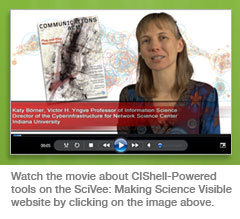Science of Science (Sci2) Tool Manual v1.1 beta
Download an offline copy of Sci2 v1.1 beta manual (57 MB) (Updated December 4, 2013)
http://www.scivee.tv/node/27704
Science of Science (Sci2 ) Tool
User Manual, v0.5 alpha
Updated 3.28.2011
Project Investigators: Katy Börner and Kevin W. Boyack (SciTech Strategies Inc.)
Programmers: Micah W. Linnemeier, Russell J. Duhon, Patrick A. Phillips, Chintan Tank, and Joseph Biberstine
Users, Testers & Tutorial Writers: Katy Börner, Hanning Guo, Scott Weingart
Cyberinfrastructure for Network Science Center
School of Library and Information Science
Indiana University, Bloomington, IN
http://cns.iu.edu
This work is funded by the School of Library and Information Science and the Cyberinfrastructure for Network Science Center at Indiana University, the James S. McDonnell Foundation, and the National Science Foundation under Grants No. IIS-0715303, IIS-0534909, and IIS-0513650. Any opinions, findings, and conclusions or recommendations expressed in this material are those of the author(s) and do not necessarily reflect the views of the National Science Foundation.
Contents
1 Introduction
2 Getting Started
2.1 Download, Install, Uninstall
2.2 User Interface
2.2.1 Menus
2.2.2 Console
2.2.3 Data Manager
2.2.4 Scheduler
2.3 Data Formats
2.4 Saving Visualizations for Publication
2.5 Sample Datasets
3 Algorithm, Tools, and Plugins
3.1 Sci2 Algorithms and Tools
3.2 Additional Plugins
3.3 Load, View, and Save Data
3.4 Memory Allocation
3.4.1 Windows and Linux
3.4.2 Mac
3.5 Memory Limits
4 Workflow Design
4.1 Overview
4.2 Data Acquisition and Preparation
4.2.1 Datasets: Publications
4.2.2 Datasets: Funding
4.2.3 Datasets: Scholarly Database
4.3 Database Loading and Manipulation
4.4 Summaries and Table Extractions
4.5 Statistical Analysis and Profiling
4.6 Temporal Analysis (When)
4.6.1 Burst Detection
4.6.2 Slice Table by Time
4.6.3 Horizontal Bar Graph
4.7 Geospatial Analysis (Where)
4.8 Topical Analysis (What)
4.8.1 Word Co-Occurrence Network
4.9 Network Analysis (With Whom?)
4.9.1 Network Extraction
4.9.2 Compute Basic Network Characteristics
4.9.3 Network Analysis
4.9.4 Network Visualization
4.10 Modeling (Why?)
4.10.1 Random Graph Model
4.10.2 Watts-Strogatz Small World
4.10.3 Barabási-Albert Scale Free Model
5 Sample Workflows
5.1 Individual Level Studies - Micro
5.1.1 Mapping Collaboration, Publication, and Funding Profiles of One Researcher (EndNote and NSF Data)
5.1.2 Time Slicing of Co-Authorship Networks (ISI Data)
5.1.3 Funding Profiles of Three Researchers at Indiana University (NSF Data)
5.1.4 Studying Four Major NetSci Researchers (ISI Data)
5.2 Institution Level Studies - Meso
5.2.1 Funding Profiles of Three Universities (NSF Data)
5.2.2 Mapping CTSA Centers (NIH RePORTER Data)
5.2.3 Biomedical Funding Profile of NSF (NSF Data)
5.2.4 Mapping Scientometrics (ISI Data)
5.2.5 Burst Detection in Physics and Complex Networks (ISI Data)
5.2.6 Mapping the Field of RNAi Research (SDB Data)
5.3 Global Level Studies - Macro
5.3.1 Geo USPTO (SDB Data)
5.3.2 Congressional District Geocoder
6 Sample Science Studies & Online Services
6.1 Science Dynamics
6.1.1 Mapping Topics and Topic Bursts in PNAS (2004)
6.2 Local Impact-Output and ROI Studies
6.2.1 Indicator-Assisted Evaluation and Funding of Research: Visualizing the Influence of Grants on the Number and Citation Counts of Research Papers (2003)
6.2.2 Mapping Transdisciplinary Tobacco Use Research Centers Publications (forthcoming)
6.3 Local and Global Science Studies
6.3.1 Mapping the Evolution of Co-Authorship Networks (2004)
6.3.2 Studying the Emerging Global Brain: Analyzing and Visualizing the Impact of Co-Authorship Teams (2005)
6.3.3 Mapping Indiana's Intellectual Space
6.3.4 Mapping the Diffusion of Information Among Major U.S. Research Institutions (2006)
6.3.5 Research Collaborations by the Chinese Academy of Sciences (2009)
6.3.6 Mapping the Structure and Evolution of Chemistry Research (2009)
6.3.7 Science Map Applications: Identifying Core Competency (2007)
6.4 Modeling Science
6.4.1 113 Years of Physical Review: Using Flow Maps to Show Temporal and Topical Citation (2008)
6.4.2 The Simultaneous Evolution of Author and Paper Networks (2004)
6.5 Accuracy Studies
6.5.1 Mapping the Backbone of Science (2005)
6.5.2 Toward a Consensus Map of Science (2009)
6.6 Databases and Tools
6.6.1 The Scholarly Database and Its Utility for Scientometrics Research (2009)
6.6.2 Reference Mapper
6.6.3 Rete-Netzwerk-Red: Analyzing and Visualizing Scholarly Networks Using the Scholarly Database and the Network Workbench Tool (2009)
6.7 Interactive Online Services
6.7.1 The NIH Visual Browser: An Interactive Visualization of Biomedical Research (2009)
6.7.2 Interactive World and Science Map of S&T Jobs (2010)
7 Extending the Sci2 Tool
7.1 CIShell Basics
7.2 Creating and Sharing New Algorithm Plugins
7.3 Tools That Use OSGi and/or CIShell
8 Relevant Datasets and Tools
8.1 Datasets
8.2 Network Analysis and Other Tools
9 References


